KOD One™ PCR Master Mix for Ultra-Fast PCR
What is PCR Master Mix?
PCR Master Mix is a ready-mix of PCR reagents. PCR is widely used across molecular biology labs to amplify specific fragments of DNA. Our PCR homepage provides helpful links to more information on the basics of PCR, including resources for PCR Master Mix.
PCR Master Mix takes the guesswork out of PCR by being a batch mixture of PCR reagents at optimal concentrations that can be prepared once and divided among many PCR tubes or PCR plates. It is convenient, timesaving, and preempts possible errors in mixing, making it an ideal choice for high-throughput applications.
Common applications of PCR Master Mix are high throughput PCR and routine PCR. These mixes are ideal because they circumvent reagents being entirely left out of a reaction and delivering false negatives as a result.
For more information about types of mixes and their components, please visit our PCR Master Mix page.
Get a 30% discount on KOD One™ PCR Master Mix. Click here for the code!
Introduction to KOD One™ PCR Master Mix
Traditional PCR can take time to complete and obtain results. Unfortunately, time is a valuable resource, especially when you have numerous samples. Fast PCR allows you to obtain your results in a shorter timeframe than traditional PCR, making it an efficient option.
The new KOD One™ PCR Master Mix offers ultra-fast PCR with one of the fastest elongation rates available for high fidelity polymerases. It uses a new genetically modified hot start KOD polymerase (UKOD) to enable ultra-fast PCR while offering the highest specificity, fidelity, and yield. The KOD One™ polymerase is made of a new DNA polymerase with a significantly faster elongation time of 5 seconds per kb (5 sec/kb) by applying both the UKOD and an elongation enhancer that is unique to this product.
The KOD One™ PCR Master Mix is a flexible product, provided in a convenient, ready-to-use format, with the ability to use it directly on crude samples like blood and mouse cell lysates. In addition to crude samples, it can be used on templates containing uracils (dU). The master mix can use primers containing both inosines (dI) and dU for amplification.
The hot start KOD polymerase is antibody-inactivated with two types of antibodies that prevent the 5' → 3' polymerase activity and 3'→5' exonuclease activities. Upon heat-activation, the 3'→5' proof-reading ability of the enzyme generates blunt-end PCR products. Features like a hot-start format for specific enzyme activity, as well as higher fidelity than most polymerases, add to the flexibility of this master mix to be used in different applications.
Animation: Learn how KOD One polymerase enables PCR in < 15 minutes
KOD One™ PCR Master Mix Features and Benefits
The KOD One™ PCR Master Mix formulation offers the following advanced features:
- Ready-to-Use
- High Fidelity
- High Efficiency
- Crude Sample PCR
- High Specificity
- Primers with dI and dU
1. Ready-to-Use: Convenient 2X premixed solution of UKOD DNA polymerase, buffer, dNTPs, and MgCl2. Also, KOD One™ PCR Master Mix Blue includes a loading dye (BPB) to allow direct loading onto agarose gels.
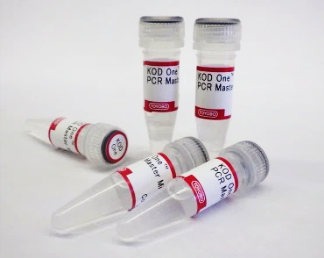
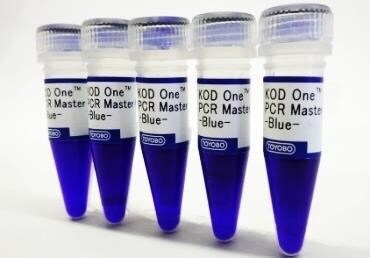
2. High Fidelity: The KOD One™ polymerase shows approximately 80-fold higher fidelity than Taq DNA polymerase.
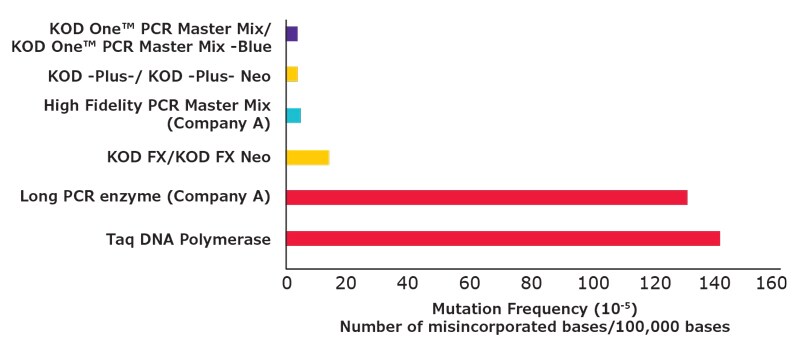
3. High Efficiency: KOD One™ PCR Master Mix enables high throughput PCR and ultra-fast PCR cycling conditions with an extension time of as quick as 5 sec/kb.
| Reaction Mix | |
|---|---|
| KOD One TM PCR Master Mix | 10 µL |
| 10 µM Fwd | 0.6 µL |
| 10 µM Rev | 0.6 µL |
| 4 ng/µL Human genome | 1 µL |
| H2O | Up to 20 µL |
| PCR Conditions | |
|---|---|
| 98oC, 0:10 | |
| 60oC, 0:05 | |
| 68oC, 0:01 | X30 |
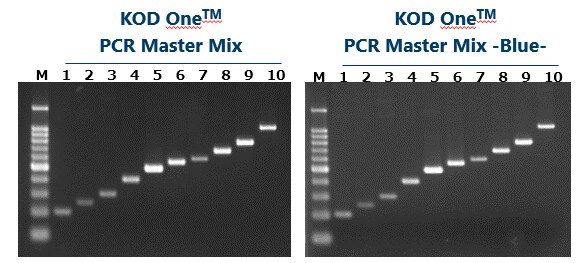
Fast PCR: Amplification time using very short cycling conditions
<1 kb: 1 sec
1-10 kb: 5 sec/kb
>10 kb: 10 sec/kb
| 1 | 200 bp |
| 2 | 250 bp |
| 3 | 300 bp |
| 4 | 400 bp |
| 5 | 500 bp |
| 6 | 550 bp |
| 7 | 600 bp |
| 8 | 700 bp |
| 9 | 800 bp |
| 10 | 1,000 bp |
| M | 100 bp DNA Ladder |
4. Crude Sample PCR: KOD One™ PCR Master Mix is effective for direct PCR amplification of crude samples such as biological samples, food samples, soil extract, etc.

5. High Specificity: Overcome the inhibitory effect of RNA (in cDNA) using KOD One™ PCR Master Mix to amplify specific targets in the presence of a high concentration of cDNA.
KOD One™ KOD One™ ─ Blue Company A

Company B
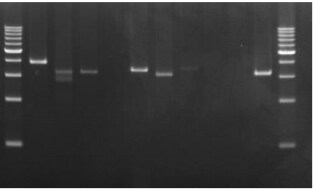
Company C
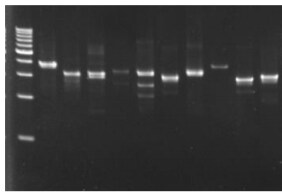
6. Primers with dI and dU: KOD One™ PCR Master Mix amplifies fragments using degenerate primers with inosines and uracils.
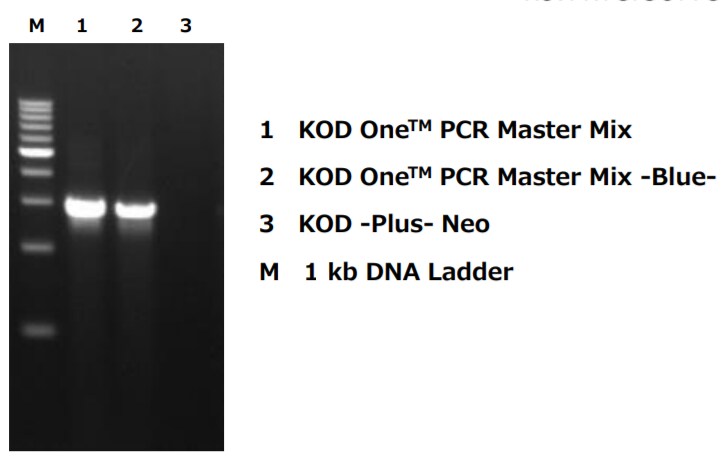
Primer sequences
Fwd: ATGGTICARATHCCICARAAY
Rev: RTGIGCYTGRTCCCARTTYTC
Relevant Applications
This product has a variety of applications including genomic DNA amplification1,2, Direct PCR, Colony PCR, NGS library amplification, and PCR amplification to detect site-directed mutagenesis (mutation generation).
A key application of KOD One™ PCR Master Mix is oncology research. In the age of genetics and researching gene-specific targets, tools like the hot start KOD polymerase are imperative for amplifying cDNA to analyze gene expression. This ultra-fast PCR product is ideal and would allow researchers to analyze gene expression more efficiently with higher yield while having low error rates due to the high fidelity when compared to other DNA polymerases.
References
To continue reading please sign in or create an account.
Don't Have An Account?